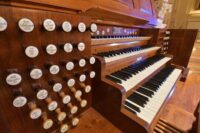The Worcester Organ
THE WORCESTER ORGAN
E. & G. G. Hook Opus 334, 1864
The Worcester Organ, installed in 1864, is the stunning focal point of our Great Hall. American organ builders Elias and George Hook, brothers from Boston, constructed the 52-stop, 3,504-pipe instrument. It has been called The Worcester Organ since its earliest days, a way of distinguishing it from the Boston Music Hall’s Walker Organ installed the previous year and then known as The Great Organ. Today it is distinguished as the oldest four-keyboard tracker pipe organ in the western hemisphere located at its installation site!
The Worcester organ is a tracker instrument—the keys and pedals are mechanically linked to the valves. When the keys and pedals are depressed, the valves open to allow air flow into the pipes. Pipe organs, particularly those installed in 19th century concert halls and cathedrals, are considered among the most complex and sophisticated “machines” ever constructed.
The Worcester County Mechanics Association commissioned the organ, which was ultimately almost $10,000 to install but even the Hook brothers realized that they could have charged more than double that price for the finished instrument. The Organ was “modernized” three times. In 1889, the pitch was lowered to A435, a pitch that recently had been adopted by most American orchestras. Hook & Hastings (the successor of the Hook brothers firm) made extensive repair and possibly some revoicing in 1914. Electro-pneumatic pulldown action was installed and modifications to the wind system were done between 1923 and 1927.
The Worcester Organ was all but forgotten when use of the Hall declined from the 1930s onward. The electro-pneumatic action deteriorated to such condition that the Organ was rendered silent. The Noack Organ Company of Georgetown, MA was engaged to restore the organ in the early 1980s. Old photographs and scavenged parts of damaged Hook organs were used to piece together an instrument very close to its authentic self, and the Organ was re-dedicated in September 1982.
Since then, the Worcester Organ has become one of the most popular and respected organs in the United States. It has been featured numerous times on National Public Radio, performed in several recordings, and has been featured on television and in a major motion picture, as well as in a music video starring Michael Crawford, the original "Phantom of the Opera."
Another extensive refurbishment was completed in 2013 by organ builder Stefan Maier of Orange, MA, in anticipation of the instrument’s 150th anniversary year. Mechanics Hall declared 2014 the Year of the Worcester Organ to commemorate the enduring legacy of the remarkable instrument. Performances were held throughout the year featuring the organ as the headliner for celebrated soloists and regional organists and accompaniment for choral musicians.
The Worcester Organ Performance Series, begun in 2007, ensures a consistent performance schedule and features young organists and established professionals, silent film and choral accompaniment. The first artistic director of the series, Dr. Frank Corbin, was succeeded by Will Sherwood (2011 – 2023) who is now Artistic Director Emeritus. Peter Krasinski was named Mechanics Hall Principal Organist and Artistic Director of the performance series in spring 2023.





